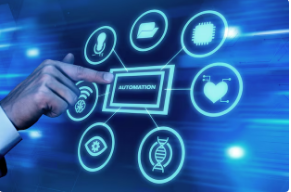The Fourth Industrial Revolution, often referred to as Industry 4.0, is characterized by the integration of automation and the Internet of Things (IoT) into manufacturing and production processes. This revolution is fundamentally changing the way industries operate, leading to greater efficiency, productivity, and innovation. This article explores the key components of Industry 4.0, its impact on various sectors, and the challenges that must be addressed to fully realize its potential.
1. Understanding Industry 4.0
Industry 4.0 is marked by the convergence of digital technologies with physical systems, creating what is known as cyber-physical systems. These systems utilize advanced technologies such as IoT, artificial intelligence (AI), robotics, big data analytics, and cloud computing to create interconnected, intelligent production environments. Key features include:
- Automation: The use of automated systems and robots to perform repetitive tasks, reducing human error and increasing efficiency.
- IoT: Connecting machines, devices, and systems through the internet, allowing for real-time data collection, monitoring, and control.
- Big Data and Analytics: Analyzing vast amounts of data generated by IoT devices to gain insights and optimize processes.
- Artificial Intelligence (AI): Utilizing AI and machine learning algorithms to make informed decisions, predict outcomes, and automate complex tasks.
- Cloud Computing: Storing and processing data on remote servers, enabling scalable and flexible operations.
2. Transforming Industries
The implementation of Industry 4.0 technologies is transforming various industries, creating new opportunities and driving significant improvements.
- Manufacturing: Smart factories are at the heart of Industry 4.0, where machines and systems are interconnected and can communicate with each other. This leads to increased automation, predictive maintenance, and real-time monitoring of production processes. For example, Siemens’ Amberg Electronics Plant uses IoT and AI to achieve near-zero defects and maximize efficiency.
- Supply Chain and Logistics: IoT devices and big data analytics enhance supply chain visibility and efficiency. Real-time tracking of goods, predictive analytics for demand forecasting, and automated warehouses are examples of how Industry 4.0 is revolutionizing logistics.
- Healthcare: IoT-enabled medical devices and wearables provide continuous monitoring of patients’ health, enabling proactive care and reducing hospital readmissions. AI-driven diagnostics and automated medical imaging also enhance the accuracy and speed of medical diagnoses.
- Agriculture: Precision farming utilizes IoT sensors to monitor soil conditions, weather patterns, and crop health. This data-driven approach allows farmers to optimize resource usage, increase crop yields, and reduce environmental impact.
- Energy: Smart grids and IoT-enabled energy management systems improve the efficiency and reliability of energy distribution. Renewable energy sources can be better integrated, and energy consumption can be optimized in real-time.
3. Challenges and Considerations
While Industry 4.0 offers numerous benefits, its implementation presents several challenges:
- Data Security and Privacy: The extensive use of IoT devices and data analytics raises concerns about data security and privacy. Protecting sensitive information from cyber threats and ensuring compliance with regulations is crucial.
- Interoperability: Different manufacturers and systems may use various standards and protocols, making interoperability a challenge. Developing common standards is essential for seamless integration.
- Workforce Skills: The shift towards automation and digitalization requires a workforce with new skills. Training and upskilling employees to work with advanced technologies is necessary to avoid job displacement.
- Initial Investment: Implementing Industry 4.0 technologies requires significant initial investment in infrastructure, equipment, and software. Small and medium-sized enterprises (SMEs) may face difficulties in affording these investments.
4. The Future of Industry 4.0
As Industry 4.0 continues to evolve, several trends and developments are expected to shape its future:
- Edge Computing: The growth of edge computing, which processes data closer to where it is generated, will enhance the speed and efficiency of IoT applications, reducing latency and bandwidth usage.
- 5G Connectivity: The widespread adoption of 5G networks will provide the high-speed, low-latency connectivity required for real-time IoT applications, further enabling Industry 4.0.
- AI and Machine Learning: Advances in AI and machine learning will lead to more sophisticated and autonomous systems capable of complex decision-making and problem-solving.
- Sustainable Practices: Industry 4.0 technologies can contribute to more sustainable manufacturing practices by optimizing resource usage, reducing waste, and lowering energy consumption.
Conclusion
The Fourth Industrial Revolution, driven by automation and the Internet of Things, is transforming industries across the globe. By leveraging advanced technologies, businesses can achieve greater efficiency, productivity, and innovation. However, the successful implementation of Industry 4.0 requires addressing challenges related to data security, interoperability, workforce skills, and initial investment. As these technologies continue to evolve, Industry 4.0 will play a crucial role in shaping the future of manufacturing and production, driving economic growth, and creating new opportunities.











